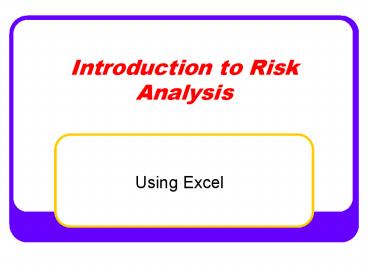Introduction to Risk Analysis - PowerPoint PPT Presentation
1 / 26
Title:
Introduction to Risk Analysis
Description:
Introduction to Risk Analysis Using Excel Learning Objective Time management Methods (1) the analytical, mathematical approach and (2) the Monte Carlo simulation ... – PowerPoint PPT presentation
Number of Views:68
Avg rating:3.0/5.0
Title: Introduction to Risk Analysis
1
Introduction to Risk Analysis
- Using Excel
2
Learning Objective
3
Time management
4
Methods
- (1) the analytical, mathematical approach and
- (2) the Monte Carlo simulation technique.
5
Warm-up
- The president of the small Pharmaceutical company
must make the final decision about whether to
market a new kind of cough drop. The yearly
forecast for this venture is as follows
6
Warm-up
- Considering a five year product live and 20
discount of the profit stream, analyze this
venture using present value method and present
some considerations about the decision based in
your calcules.(10 minutes)
7
Present Value
8
Uncertainties
9
Additional Information
- Calculate the base-case, best-case and worst-case
scenarios, through excel using these additional
information (10 minutes) - Total industry sales of cough drops will be
between 10 million and 20 million. - The company's market share will be between 20
and 50. - The price will be between 10 and 20 cents per
ounce. - The fixed cost of manufacturing will be between
100,000 and 300,000. - The variable cost rate of production will be
between 5 and 10 cents.
10
Scenarios
11
Uncertainties
- There is a great deal of uncertainty in this
venture. The board of directors is quite
risk-averse, so they want to know - How good is the base-case estimate?
- What is the variability in the profit function?
- What are the chances of making a profit?
- What are the chances of making a profit of
500,000 or more? - What is the probability of a loss?
12
What is Risk Analysis?
- Consider now that
- Marketing believes, based on past records,
competitive products, and intuition, that total
industry sales will be around 15 million. - They believe it is very unlikely that sales will
be less than 10 million or more than 20
million, but they are unable to decide the
likelihood of any particular sales figure within
that range. - Any value is equally likely. In other words,
marketing feels that the probability distribution
of total industry sales is a flat-line segment
between 10 million and 20 million, as shown in
the next slide.
13
Probability Distribution
Probability Distribution of total industry sales
14
The cumulative probability Distribution
- The probability that random variable is up to a
certain value is represented by the area under
the probability distribution.
Cumulative Probability
Cumulative Probability Distribution
1.0
0.5
15
Risk simulation process
16
Risk analysis
- Risk analysis calculates measures of uncertainty
of the output variables, such as sales, profit,
labor required, and so on. These measures include
expected value, variance, standard deviation,
median, mode, the complete output probability
distribution, and the cumulative probability
distribution.
17
Risk analysis scenarios
- The scenarios include not just single estimates
of the variables but also the calculated
probability values associated with critical
factors, and answers to such questions as - What is the probability that there will be no
profit? - What is the probability that the profit will be
over 1,000,000? - What is the probability that the project will be
late by 20? - What is the probability that the break-even point
will be under 1,000 units? - What is the probability that lost sales will be
under 1,500 units?
18
Using Excel step 1
- The first thing you need to learn is how to
generate random numbers using the Excel function
RAND(). - When you enter this function, a random number
between 0 and 1 appears. - This is an unusual function, for two reasons.
First, it has no argument that is, nothing goes
inside the parentheses. However, the parentheses
are required. Second, each time the worksheet is
recalculated, a new random number appears
automatically. You should play with the RAND( )
function to understand how it works.
19
Uniform random number
- Uniform random distribution between the lower
limit L and upper limit U - "L((U-L) RAND())".
- For whole numbers
- "RANDBETWEEN(100,150)"
20
The model
Open the model
21
The model
22
Runs
In order to repeat the simulation, a table was
built in cells B25 to C124 based on the results
in cells B11 and B12.
23
Results
24
Results
- Cells B15 to B21 summarize the results of the
table. These of runs. - The average will hover around 190,000.
- The values of sigma and CF are warnings of the
uncertainty involved. Indeed, the probability of
loss hovers around 22.
25
Probability Distribution function
26
Making Decision
- The expected yearly profit is 193,402.
- The standard deviation is 224,911.
- There is approximately a 20 chance of a loss.
- There is approximately an 18 chance that the
yearly profit will be greater than 400,000.
27
Reference
- Operations Analysis Using Excel. Weida
Richardson and Vazsony, Duxbury, 2001, Chapter 12.































